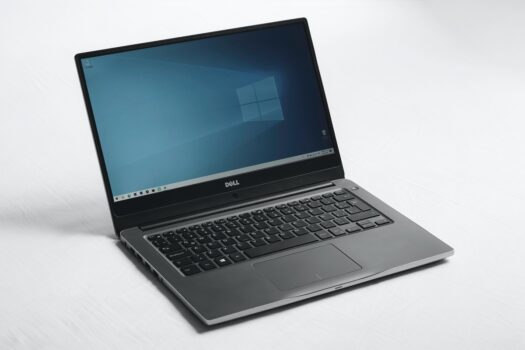When choosing the best laptop for architects, people often look at the price before anything else, which clouds their judgment.
Laptops for architects are indeed priced higher because of their graphics-intensive features to run complex programs and applications smoothly. This leads consumers to think there isn’t much difference between, say, an NVIDIA GeForce GTX 1660 graphics card and a 3060 model.
But architecture laptops are unique because even a seemingly minor change can impact how the design or project looks on screen. There’s a lot to consider, and since most people have a tough time grappling with the intricacies of these machines, we have a solution.
All you have to do is read our guide because we have highlighted the features of top laptop brands and what makes them ideal for architects.
Best Laptops For Architects

We have adopted a slightly different approach in this section to discuss the best laptops for architects. Rather than telling you about the top models, we have looked at the best laptop brands available online.
Everyone has specific requirements, and knowing about the top brands will help refine your search.
1. Apple Macbook
A common dilemma for people is choosing between Apple or other laptops due to the difference in CPU performance. But the new Apple M1 Max and M2 chips can support both heavy and traditional design software. You can enjoy a smooth performance while editing HD videos, rendering image files, or compiling audio.
Moreover, Apple laptops feature a turbo boost technology and have a hyper-threading function to run simultaneous threads on each core. And thanks to the Thunderbolt ports, it’s possible to transfer data 12 times faster for greater convenience.
2. Dell
Intel 12th Gen Dell laptops come with a dedicated graphics card and Windows 11 operating system. You can choose the 16GB DDR4 memory, having a speed of 3200 MHz, and also expand to a 512GB or 1TB SSD if needed.
Especially noteworthy are the HD display and large screen size, complete with anti-glare and ComfortView support. But what makes a Dell laptop worth investing in is the durable design, which consists of an aluminum exterior shell and a precision Mylar touchpad.
Architects will also love the inbuilt speaker and camera, while the integrated 4-cell battery delivers long battery life.
3. Asus
Among affordable gaming laptops, many people opt for Asus due to the popularity of the Asus Zenbook Pro Duo models. These laptops feature 12th Gen Intel Core i7 processors and have NVIDIA GeForce RTX or NVIDIA GTX GeForce GPU. But the best part is the brand’s Intelligent Performance Technology to run heavy design software without lagging.
ASUS innovative screen pad and 4K resolution screen are perfect for creating intricate designs on various projects. We even found a 1TB SSD storage with a read speed of 6,500 MB/s that’s supported by a thin and lightweight design.
4. LG
LG manufactures ultra-smart laptops that come with Windows 11 supported by a 12th Gen Intel Core i7 processor. The standout feature for architects will be the large screen, with some models having a 17-inch HD display and a resolution of 2500×1600.
You can also opt for touchscreen and anti-glare models for greater convenience, even though it isn’t necessary. But ensure that your preferred laptop has a multi-card reader, Thunderbolt, and HDMI ports.
Especially pleasing for architecture students will be the innovative secondary screen, whereby they can transfer files through face and gaze tracking.
5. HP
When choosing the latest HP laptop for architects, it isn’t easy to look past the HP pavilion series. These models have a 12th Gen Intel Core i7 or i5 processor with a speed of 1.2Ghz. Although the laptops might be slightly less powerful than other options, they are equipped with Windows 11 and a 512GB SSD.
A problem with most high-end laptops is the battery swelling or overheating after regular use, which HP has managed to resolve. It has further kept its laptops sleek and lightweight despite including a backlit keyboard.
6. Microsoft
Before enrolling in an architecture curriculum, it’s natural to think – “do you need a specific laptop for architecture?” Yes, you will need laptops with integrated graphics memory and enhanced thermal performance to run most tasks smoothly; that’s where Microsoft comes in.
Its latest models feature an Intel Core i7-2700T processor with 16GB memory and 512GB SSD. 12 cores, and 24 threads deliver a maximum clock speed of 4.8GHz, further equipped with an NVIDIA GeForce RTX 4050 Ti graphics card.
These laptops also have a backlit display and a 10-point multi-touch screen encased in a magnesium and aluminum body.
7. Razer Blade
Like Microsoft, Razer Blade laptops have a 12th Gen Intel Core i7 processor but what makes them unique is the dual-channel memory. These models have a 1TB SSD with an open M.2 PCIe slot for further expansion.
Architects will enjoy designing on the 15.6-inch screen while Intel’s turbo boost technology increases the CPU speed upto 5.6GHz to reduce lagging. Other noteworthy features include the anti-ghosting per-key backlighting and the precision glass touchpad.
Razer laptops even have a dedicated graphics card which makes them among the most affordable gaming laptop brands.
8. Acer
Acer has used advanced hybrid architecture with graphics processors from the NVIDIA GeForce RTX 30 series for its 12th Gen laptops. There are 2 large storage slots for optimum performance – the Gen 4 M.2 PCIe and 32GB DDR4 3200 MHz RAM.
These models are perfect for handling various projects with their 14 cores and 20 threads, helping you chat, stream, browse, or edit seamlessly. They deliver a more immersive experience while a 17.3-inch QHD screen supports the superfast refresh rate of 165Hz.
You will also find a dual fan cooling system and a quad-exhaust port to keep the laptop cool.
Factors To Consider When Choosing The Best Laptop For Architecture?

You can’t choose any laptop for an architect because their requirements are very different from other professions. To pick a reliable laptop, it must support graphics-intensive software, have the latest operating system, and feature excellent screen resolution.
These are just some of the many factors you need to remember, so we have shortlisted the essential features and their specs to help you.
1. Processor
You might think that laptops with a 10th Gen Intel Core i5 processor will work just fine, but that’s the problem. The devil is in the detail – why use a laptop that works “just fine” when you can choose a powerful laptop with 11th or 12th Gen Intel Core processors?
In simple terms, the processor is the brain of a laptop that allows you to multitask and use all the latest programs without it lagging. Depending on the architecture software and programs you need to handle, choose laptops with the latest generation processor for graphics-intensive tasks.
2. Display
Ensure that the laptop has an HD screen with a minimum resolution of 1920×1080. This will allow you to view projects in great detail and make minute changes to stand out among fellow architects. The better the color accuracy and dynamic range of a laptop, the easier it is to use the latest architectural software.
An even better prospect would be investing in an HD laptop with a large screen size that supports a 4K display. This will allow you to bag high-profile job offers and create intricate designs based on clients’ requirements.
3. Storage
Storage is essential when choosing laptops for architects, but you must consider both SSD and HDD storage. Solid state drives are better at retrieving information quickly but cost more and don’t offer as much storage as a hard disk drive.
An easier way to decide which premium laptops to use is to determine the relevancy of the files. If you access the files regularly, opt for SSD, but go with HDD when you want to archive files.
Some of the best laptops for architects have both storage options, but if you want just one, choose SSD. It’s always possible to expand the storage with an external hard drive for storing large files later.
4. GPU
The GPU, along with the CPU, helps the laptop deliver faster results when you are working on high-end applications. Since the CPU doesn’t have to process the graphics, thanks to the GPU, the laptop runs smoother even when rendering or working on high graphics programs.
Using a laptop with an upgraded GPU will come in handy if you have to render 3D models and complicated projects to bag a deal with clients. For your first laptop, you can use a GPU having 4GB RAM, but if you need a slightly better model, opt for a GPU RAM size of 6-8GB.
5. RAM
Most architects have to handle 3D modeling applications on their laptops, for which a powerful RAM is vital. It’s the working memory of the device and determines how well the laptop functions to deliver the desired results quickly.
You should ensure that the laptop can manage multiple applications simultaneously without lagging. While some architects start with an 8GB RAM, it will hardly serve your purpose for even basic architecture programs.
The best thing to do is use 16-32GB RAM, provided you have the budget. But if you can pull it off, the processor will run smoothly despite extended hours of operation on intricate tasks.
6. Battery Life
When you find a laptop that satisfies the above criteria, don’t forget to check the battery life. Using a laptop that loses power quickly is hardly convenient, even if it’s an affordable gaming laptop.
It wouldn’t be wise to compromise on good battery life since you might have to move around quite a bit between classes and client appointments. And the last thing you would want is for the laptop to lie unresponsive and an angry client or teacher to contend with.
We recommend a minimum runtime of 8 hours, possibly with a 54Wh battery that delivers fast charging.
Laptop Brands For Architects Frequently Asked Questions ?
What are the best laptops for architecture design?
Choosing the best laptop for architecture depends on your personal preference, the field you are working in, and the project size. While beginners can opt for more affordable devices, as a professional architect, it would be best to choose from the following options:
-
- Microsoft
- Acer
- MSI
- HP
- Lenovo ThinkPad
These are some of the most reliable brands suitable for architecture design and support high graphics-intensive applications.
Can you use a gaming laptop for architecture?
Yes, it’s possible to use gaming laptops for architecture projects but make sure they at least have an NVIDIA GeForce GTX 1660 graphics card. Certain budget laptops don’t have the necessary specs and fail to run high-end architecture design software.
Another important thing to consider is the speed when using multiple applications simultaneously. As a rule, opt for laptops with an M.2 solid state drive for optimum performance on complex tasks.
What RAM size do you need for architecture projects?
The best laptops come with RAM between 16 and 32GB, so that should be your minimum requirement. Anything less than 16GB will make it challenging to use the latest architecture software, which could result in low output.
You can choose basic laptops initially when a smaller RAM size will suffice for simple architecture design tasks since it’s possible to upgrade the RAM later. Another thing to note is whether the laptop has at least a 4GB graphics card.
Are Intel Core i5 processors suitable for architecture students?
Intel Core i5 processors are a good investment for architecture students, but they are not the best since Intel i9 and i7 processors deliver a more powerful performance. Beginners can choose Core i3 processors because they are more affordable than an Intel Core i7 processor and should suffice for basic applications.
But the laptop will lag when you run multiple programs, so a mid-range processor like i5 will be a better choice.
Is MacBook Pro good for architecture?
If you have set your mind on using the MacBook Pro, ensure it has a 16-inch high-resolution screen to make minute changes to your projects. Most people prefer Windows laptops over the Apple MacBook Pro or MacBook Air since they support multiple applications.
Ensure the MacBook can run architectural modeling and re-designing programs to create 3D and 2D blueprints. In other words, it should have a good CPU and GPU for you to use the necessary architecture software.

Laptop Brands For Architects Conclusion
Depending on the projects you handle, choose a lightweight laptop with good processing power and an IPS display.
A common question that most people ask is – do architects need graphics card? Let us tell you that while you can opt for less advanced laptops initially, never compromise on the graphics card. Even when purchasing good mid-range laptops, ensure that you use Intel’s Iris Xe graphics or one of the higher NVIDIA GeForce series products.
Architecture software and design tasks put a lot of pressure on a laptop to perform at optimal capacity. But if you stick to the features we have discussed, the laptop will deliver a smooth experience and faster results to make your projects stand out.


